
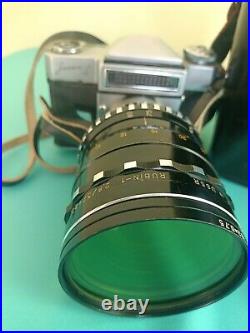
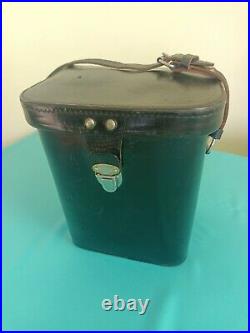
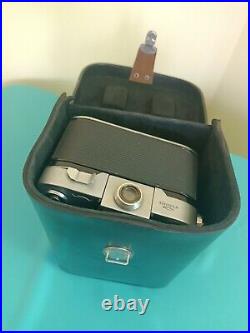
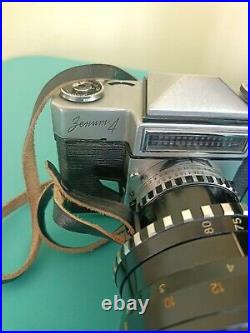
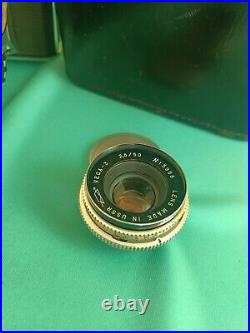
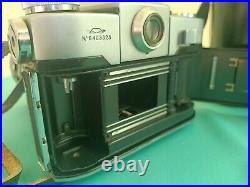
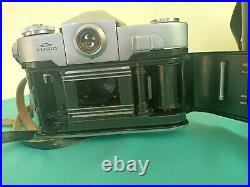
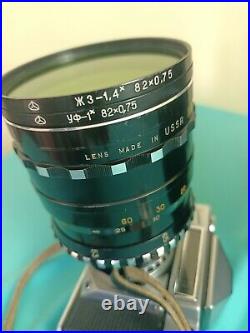

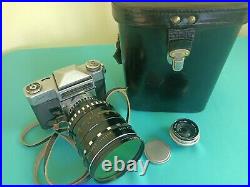


Photographic material Film type 135. The exposure is a semi-automatic installation using a conjugated selenium exposure meter. Shutter speeds from 1 to 1/500 seconds and "B" (by hand). Flash Synchro contact "X" and "M", synchronization at all exposures. Mirror viewfinder with removable pentaprism.
Dimensions (with Vega-3C lens) - 141×84×104 mm. Weight (with Vega-3C lens) - 1000 g. Wikimedia Commons logo Media files on Wikimedia Commons. Zenit-4 is a small-format single-lens reflex camera with a central lens shutter and interchangeable lenses, which was mass-produced from 1964 to 1968 at the Krasnogorsk Mechanical Plant. The first SLR camera in the USSR with semi-automatic exposure control[1].
The basic model of the family of the same name, which also included the Zenit-5 and Zenit-6 devices[2]. The Zenit-6 camera was regularly equipped with the first Soviet photozoom "Rubin-1TS"[3]. Another camera of this line called the Zenit-11 was a prototype of the Zenit-4 without an exposure meter[4][5].
The camera was not mass-produced, and subsequently this index was assigned to a completely different model[6]. By the early 1950s, the reserves for improving the curtain shutter were considered exhausted, and designers began to abandon it in favor of the petal[7][8][9]. The latter was devoid of such disadvantages as a rolling shutter and uneven exposure along the frame due to the acceleration of the blinds[10]. The trend has accelerated with the spread of electronic flashbulbs, with which the central shutter is synchronized at any shutter speeds[11][12]. An additional factor was the convenience of the mechanical implementation of the principle of light numbers, fashionable in those years [13]. The West German engineers were the first to implement the idea of installing a petal shutter in a single-lens "DSLR" in an attempt to seize the initiative from Japanese competitors[14]. Contaflex, released in 1953, was well received by amateur photographers and quickly became the subject of numerous imitations[15].
In the following 1956 models, it became possible to replace the front half of the lens located in front of the interline shutter [16]. The camera and the entire Zenit-4 family were created in line with another German trend implemented by Voigtländer and Futura[17]. The lenses of these cameras were located in front of the central shutter and changed entirely [1]. A group of developers led by Grigory Dorsky took the Bessamatic camera and the optical design of its lenses as a basis.
The main fundamental solutions are borrowed from the German analogue, but in general the camera is original and even surpasses the prototype in a number of possibilities [8][19]. The DKL "Dekel bayonet", popular in those years, was inherited from the "Bessamatic", although its working segment was lengthened[2] from 44.7 to 47.58 millimeters[22][2]. The assembly of such a bayonet, in addition to mounting the lens, also included the shutter itself and the diaphragm control drive [23][24]. Due to complex gears, the shutter speed rings and the lens aperture are connected to the exposure meter and to each other, forming a summing device for selecting the most advantageous exposure pair with mechanical automation of compliance with the law of interchangeability[25].
The relative position of the shutter speed and aperture rings is synchronized, ensuring constant compliance of the combinations of both parameters with the selected exposure number[26][3]. In 1965, a line of interchangeable lenses of the "C" series with a jumping aperture, specially developed in GOI for cameras with a lens shutter, was prepared for production[30].
Absolutely uniform exposure throughout the frame can only be provided by aperture shutters installed between the lenses close to the diaphragm. But this arrangement excludes the replacement of the lens separately from the shutter [4]. Therefore, as with most foreign 35 mm analogues, the Zenit-4 shutter is placed immediately behind the last lens of the lens. To reduce shutter vignetting, all interchangeable optics were specially designed: its exit pupil was calculated to be extremely small, reducing the available aperture[17]. The unacceptability of a large gap between the rear lens and the shutter limited the extension of the lens, and even the regular Vega-3C because of this did not focus closer than 1 meter, excluding close-up shots.
As a result, the camera surpassed simpler and more reliable rangefinder cameras only by the absence of the viewfinder parallax, losing all other advantages of the "DSLR". Like foreign analogues, Zeniths with a central shutter turned out to be several times more difficult than conventional SLR cameras, and broke down much more often[16]. At the same time, interchangeable lenses, as well as an adapter for optics from threaded Zeniths, have not been mastered by the industry. Therefore, the release of the most massive 4th model was limited to a circulation of only 19,740 pieces[34].
To obtain the correct exposure pair, you need to combine the hole of the wide arrow with the thin arrow of the galvanometer. The arrows of the exposure meter are located in the field of view of the viewfinder, allowing you to control the exposure without taking your eyes off the eyepiece[40]. Together with the Deckel bayonet, the mechanism for marking the boundaries of the depth of field with movable flags on the rim was borrowed[41]. The role of the trigger button is performed by a key on the side of the lens. At the same time, there is a socket for the trigger cable on the opposite side. In addition to the standard type-135 cassettes, the camera supported cassettes from the "Zorky-6" with a spring-loaded flocked mouth. When closing the back wall, its special protrusion turned the inner cylinder of the cassette, slightly opening the mouth for the free passage of the film.
For the Zenit-5 camera, which is sensitive to the pulling force, these cassettes were mandatory. Rewind the film using a tape measure, not a cylindrical head. The roulette wheel is located in an unusual place: on the side wall of the camera.
Automatic frame counter that resets to "0" when the back wall is opened[42]. Glass presser table that practically does not wear out and does not scratch the film[5]. In the line of interchangeable optics there was the first in the USSR zoom lens "Rubin-1", which was not produced for other types of mirror equipment[43].
The peculiarity of the Zenit-4 shutter is that it has two independent lobe drives. In addition to the main drive from the working spring, an auxiliary one is provided, opening and closing the petals for the operation of the mirror viewfinder [45]. Zenit-4 with the pentaprism removed.
When the shutter is cocked and the film is transferred, the frame window is closed by a metal flap hinged under the mirror. The mirror is lowered into the working position, and the petals of the central shutter are opened by an auxiliary drive. At the same time, the film is rewound to the frame step and the jumping diaphragm opens. Thus, the light gets access through the lens to the viewfinder, and the film is protected by a shutter from illumination. The photographer can make sighting, framing, focusing and semi-automatic exposure control without taking his eyes off the eyepiece.
To select the correct exposure, a cylindrical head is mounted on the upper flap, kinematically connected through a summing mechanism to the diaphragm and shutter. By rotating it, the position is found at which two movable arrows in the field of view of the viewfinder are aligned with each other. At this moment, the shutter speed and aperture rings automatically occupy positions corresponding to the correct exposure. This item is in the category "Cameras & Photo\Lenses & Filters\Lenses". The seller is "svetlana-8867" and is located in this country: KZ. This item can be shipped worldwide.
- Model: KMZ
- Type: High Quality
- Brand: Zenit
- Mount: EF Mount

